
FM 21-150 COMBATIVES 1992
.pdf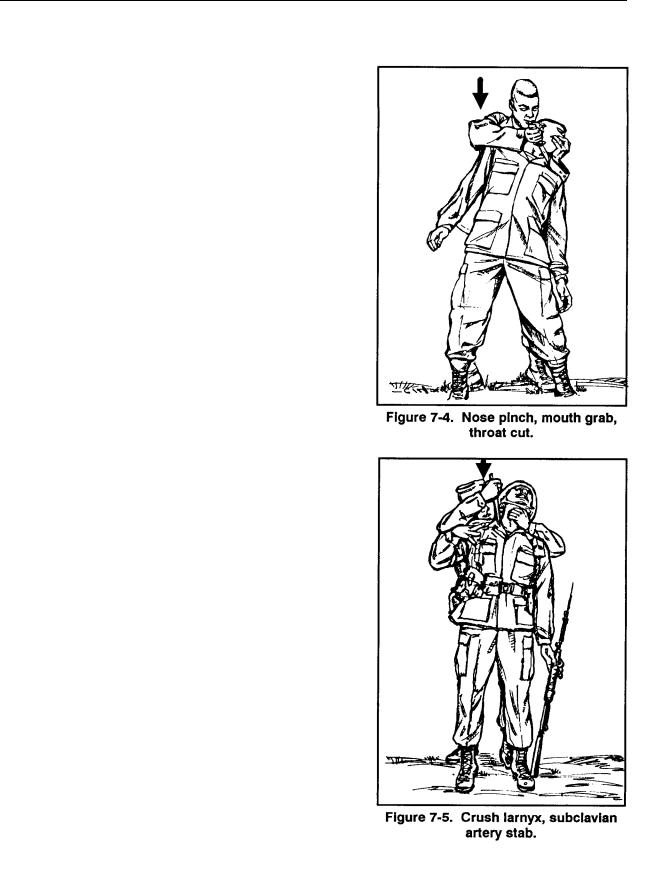
FM 21-150
d. Nose Pinch, Mouth Grab,
Throat Cut. In this technique, completely pinch off the sentry’s mouth and nose to prevent any outcry. Then cut his throat or stab his subclavian artery (Figure 7-4). The danger with this technique is that the sentry can resist until he is killed, although he cannot make a sound.
e. Crush Larynx, Subclavian
Artery Stab. Crush the sentry’s larynx by inserting the thumb and two or three fingers behind his larynx, then twisting and crushing it. The subclavian artery can be stabbed at the same time with the other hand (Figure 7-5).
7-6
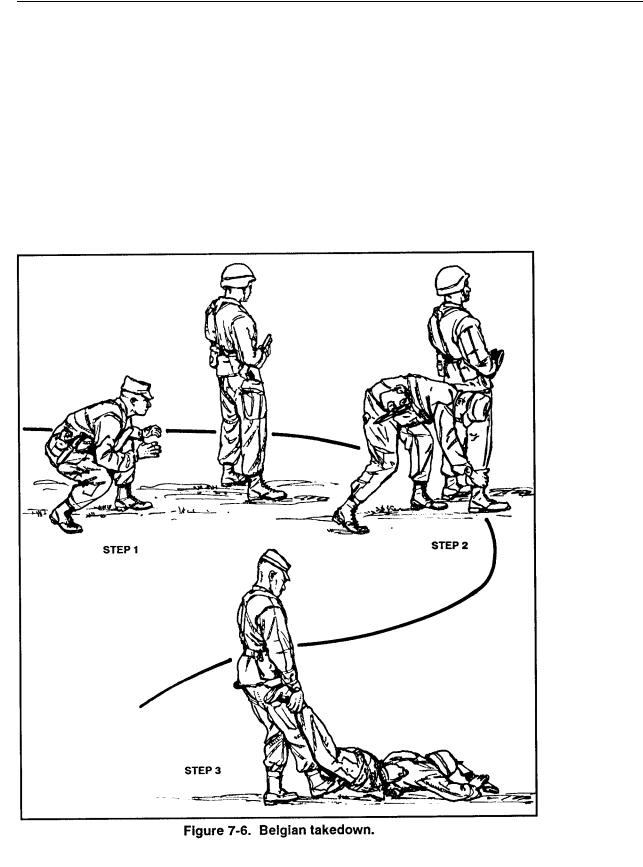
FM 21-150
f. Belgian Takedown. In the Belgian take down technique, the unsuspecting sentry is knocked to the ground and kicked in the groin, inducing shock. The soldier can then kill the sentry by any proper means. Since surprise is the essential element of this technique, the soldier must use effective stalking techniques (Figure 7-6, Step 1). To initiate his attack, he grabs both of the sentry’s ankles (Figure 7-6, Step 2). Then he heaves his body weight into the hips of the sentry while pulling up on the ankles. This technique slams the sentry to the ground on his face. Then, the soldier follows with a kick to the groin- (Figure 7-6, Step 3).
7-7
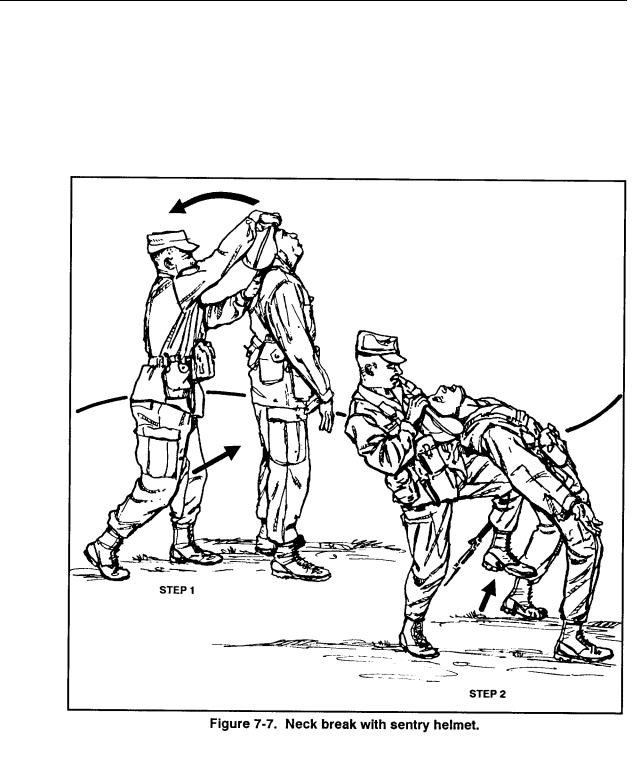
FM 21-150
g. Neck Break With Sentry Helmet.The soldier can break the sentry’s neck by vigorously snatching back and down on the sentry’s helmet (Figure 7-7, Step 1) while forcing the sentry’s body weight forward with a knee strike (Figure 7-7, Step 2). The chin strap of the helmet must be fastened for this technique to work.
7-8
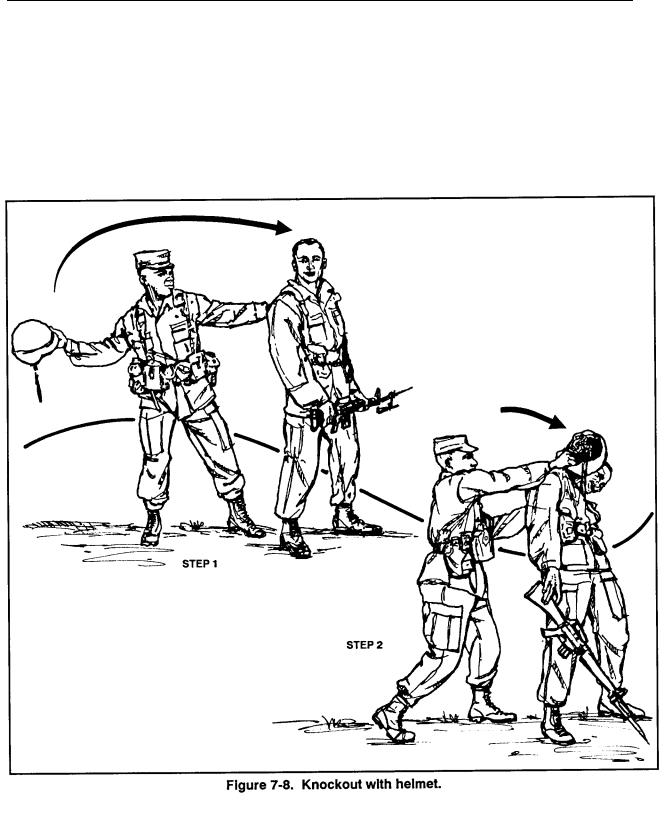
FM 21-150
h. Knockout With Helmet.The sentry’s helmet is stripped from his head and used by the soldier to knock him out (Figure 7-8, Step 1). The soldier uses his free hand to stabilize the sentry during the attack. This technique can only be used when the sentry’s chin strap is loose. The preferred target area for striking with the helmet is at the base of the skull or on the temple (Figure 7-8, Step 2).
7-9

FM 21-150
i. The Garrote. In this technique, use a length of wire, cord, rope, or webbed belt to takeout a sentry. Silence is not guaranteed, but the technique is effective if the soldier is unarmed and must escape from a guarded area. The soldier carefully stalks the sentry from behind with his garrote ready (Figure 7-9, Step 1). He loops the garrote over the sentry’s head across the throat (Figure 7-9, Step 2) and forcefully pulls him backward as he turns his own body to place his hips in low against the hips of the sentry. The sentry’s balance is already taken at this point, and the garrote becomes crossed around the sentry’s throat when the turn is made. The sentry is thrown over the soldier’s shoulder and killed by strangling or breaking his neck (Figure 7-9, Step 3).
7-10
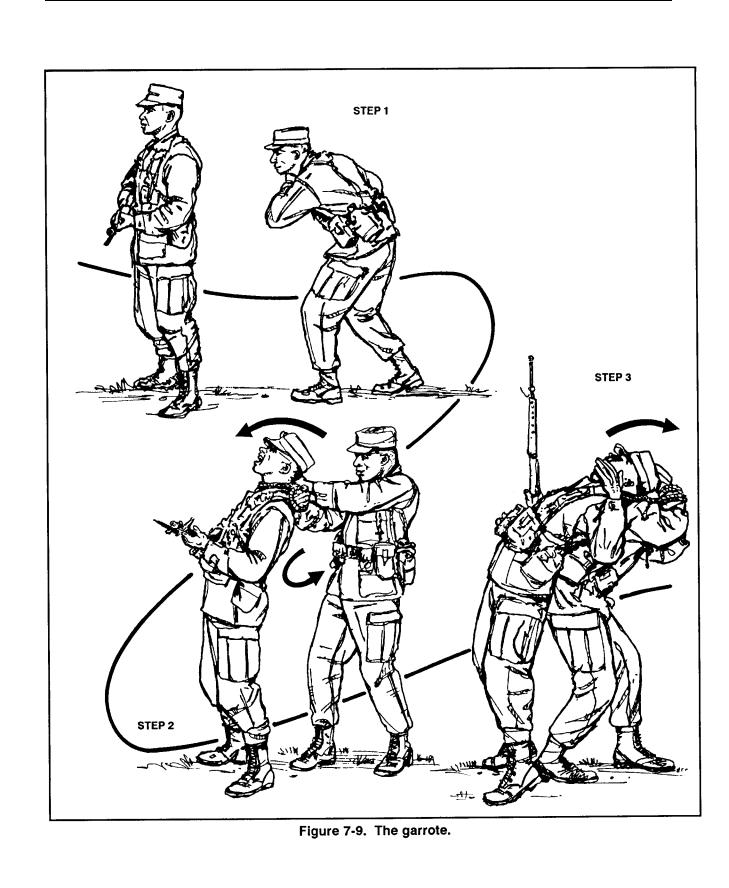
FM 21-150
7-11
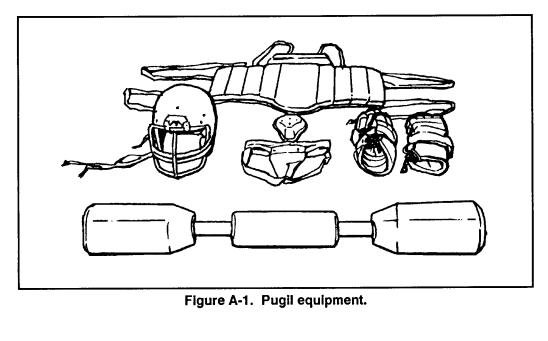
APPENDIX A
PUGIL TRAINING
Training in pugil techniques prepares the soldier to confidently and aggressively use the rifle-bayonet. It furnishes the rifle-bayonet fighter with an opponent who can think, move, evade, fight back, and (most important) make corrections. It provides realism.
Section I
EQUIPMENT
Pugil equipment consists of the pugil stick and protective gear that is especially designed to protect the soldier during training. It allows the soldier to participate in pugil training without incurring or fearing injury. Participation with no fear of injury helps the soldier to develop an individual style of fighting and improve his ability to fight with the rifle and bayonet. Pugil equipment (Figure A-1) is designed to prevent injuries to the head and face, chest, groin, and hands.
A-1
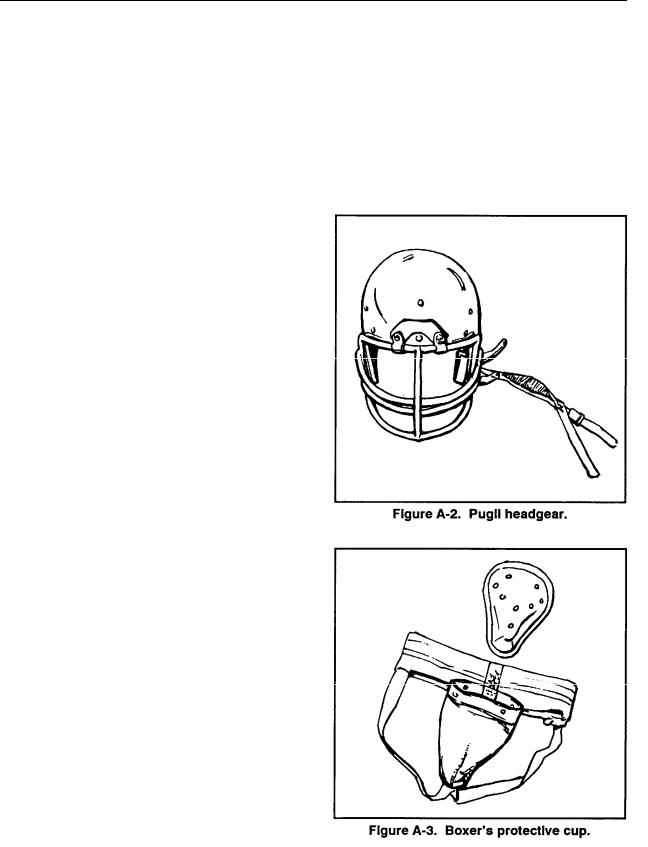
FM 21-150
A-1. SECURING EQUIPMENT
Units can construct pugil sticks or obtain them from the Training Support Center. The helmets with attached face masks, gloves, chest protectors, and boxers’ protective cups are nonstock-type commercial items. Locally used nonstandard stock numbers identify these commercial items, which are obtained through TSC or local purchase.
A-2. HEADGEAR
Headgear consists of a regulation football helmet with a face mask attached (Figure A-2). When purchasing these helmets, you should consider the varying head sizes of individuals. For each 100 helmets purchased, it is recommended that 10 percent be 6 1/2 to 6 3/4 in size, 80 percent be 6 7/8 to 7 1/8 in size, and 10 percent be 7 1/4 to 7 1/2 in size. Adjust helmets that are too large for an individual by adding foam rubber to the inside of the helmet. To secure the helmet to the head, use a chin strap made of vinyl plastic and foam rubber.
A-3. GROIN EQUIPMENT
A boxer’s protective cup of the
variety used in athletic
competition protects the groin
(Figure A-3).
A-2
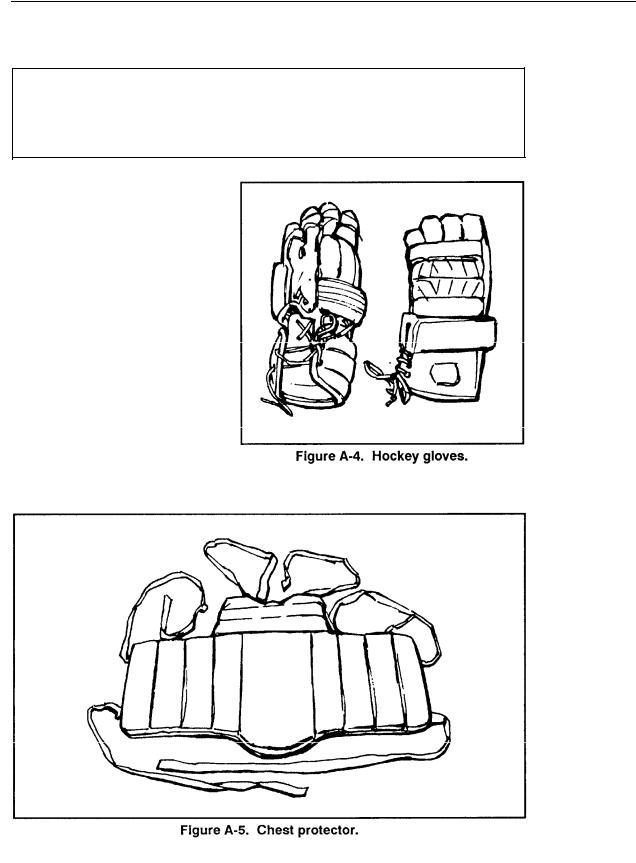
FM 21-150
CAUTION
GLOVES AND CHEST PROTECTORS MUST BE WORN DURING
TRAINING.
A-4. HAND EQUIPMENT
Gloves are required in pugil training. Hockey gloves (Figure A-4) provide maximum protection for the fingers and joints of the hands and wrist and aid in controlling the stick.
A-5. CHEST PROTECTORS
Soldiers must use chest protectors (Figure A-5) during pugil training to prevent injuries. Baseball catchers’ chest protectors or martial arts protectors are recommended. If chest protectors are unavailable, substitute flak vests.
A-3
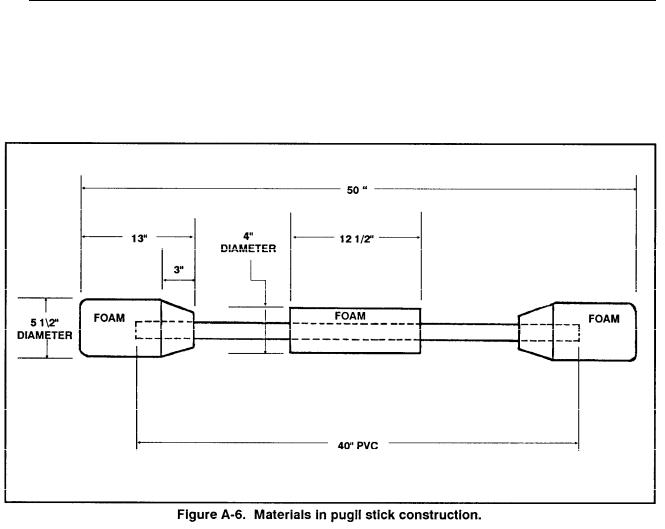
FM 21-150
A-6. PUGIL STICK
Pugil sticks (Figure A-6) may be obtained from the local TSC or call Devices Section, TSC, Ft Benning, GA, DSN 835-1407.
Section II
TECHNIQUES
Pugil training is a way to teach the soldier to use the rifle-bayonet with confidence and aggression. After the soldier becomes skilled in the basic positions and movements with the rifle-bayonet, he should be introduced to pugil training techniques.
A-7. VALUE OF PUGIL TRAINING
Since pugil fighting is a rugged contact activity, the soldiers must remain alert. They act and react from instinct, thus affording an opportunity to develop their individual rifle-bayonet fighting skills. Little effort is required by the instructor to motivate the soldiers—the pugil stick is the motivating force. Soldiers derive much physical benefit from pugil training, and they develop an aggressive mental spirit that is so essential if the rifle-bayonet fighter is to be successful in combat (Figure A-7).
A-4
